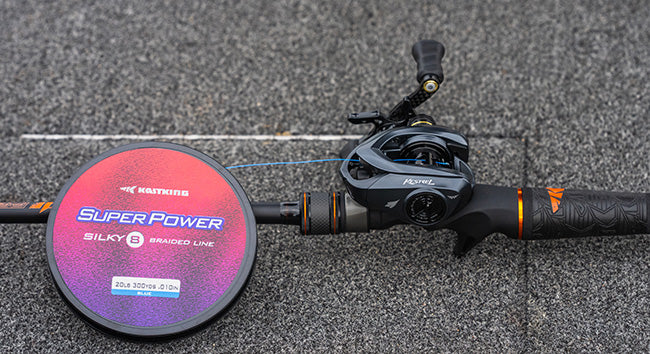Braided fishing line is a popular choice for bass fishermen but isn’t as widely accepted in trout fishing. While every type of line, monofilament, fluorocarbon, and braid have their benefits for trout fishing, it is apparent that braid hasn’t gotten its share of the consideration for anglers. Choosing the right braided line for trout fishing is no different than selecting a fishing line for any other style of fishing. Once an angler has considered the pros and cons of the line, the only factors to weigh are the species they are targeting. Since trout run from small stream-dwelling species to enormous lake species, this article will cover recommendations in two sections: small and large trout.

Advantages of Braided Fishing Line
For anglers familiar with braided fishing lines, its advantages of smooth casting are well known; however, trout are unique fish whose discerning feeding styles lead to certain aspects of braided line to be even more important.
No stretch
No stretch makes long hooksets easier. This isn’t often a problem for floating down a stream, but when trolling for lake trout using a downrigger, the lack of stretch is a significant advantage.
Most braided lines float
The natural buoyancy of braided line makes it ideal for fishing higher in the water column. When anglers drift, salmon eggs or fish swim baits. The added float helps keep the baits suspended in the strike zone.
Braided line has very low or no memory
A lack of memory in braided fishing line is ideal when fishing light lures. A twisted or “loopy” line, such as monofilament stored too long, will negatively affect how a lure acts in the water. The lack of memory also means that line comes off the spool smoother and casts longer distances than other line styles.
Brained lines are extra strong for their diameter
One of the biggest benefits for anglers is the strength of the diameter of braided fishing line. With a comparable breaking strength to monofilament of, on average, four times thicker, the narrow braided line means anglers can spool up much more line than with mono. Line capacity allows anglers to fish deeper lakes or pack more line onto small reels.
Braided lines are more sensitive
The sensitivity of braided line helps anglers detect strikes when bottom bouncing or drifting. Detecting the gentle take of a trout even in running water gives anglers a major edge.
Disadvantages
For all the benefits of braided line for trout, there are some disadvantages that should be considered.
Visibility
Bradied line is more visibile than floruocarbon or monofilamanet. Anglers fishing clear lakes and mountain streams will need a long leader to avoid spooking fish.
Braid is not forgiving
Braided fishing line is a no-stretch line. While the lack of stretch is great for hard hooksets, it can also be too unforgiving and put undue strain on the leader. Anglers fishing thin leaders need to take extra caution to not horse the fish in and potentially break the leader.
Braid can snag
In areas where sunken logs and blowdowns are common braided line can be a disadvantage. The inability of braid to stretch can result in line cutting into waterlogged timber rather than sliding over it. That’s not to say anglers can’t use braided line around timber, but they should be aware that the strength of braid can mean they won’t be able to free some snags the same way as with monofilament.
Now that braided fishing line has been covered with its advantages and disadvantages; it’s time to dive into line recommendations for different species. These are relatively broad groups of trout, so what may be ideal for one species may need to be adjusted slightly for another.
Small trout
Smaller trout species like rainbow, brook and cutthroat trout are commonly caught in clear streams and rivers. The clarity of the water and excellent eyesight of these fish require a super fine low visibility line.
KastKing KastPro 13X Finesse Braid Fishing Line
The KastKing KastPro 13X is a super thin braid with incredible sensitivity. With a thickness 75% thinner than comparable monofilament, the size pound braid will be thinner than most ultra-light lines.
KastKing SuperPower Silky8 Braided Line
The Sliky8 makes a great option for trout anglers looking to make the longest casts possible with light baits. The silky is responsive and incredibly flexible, even with light lures. No roostertail is too small for this braid.
Large trout
Large trout like steelhead, lake trout, and bull trout require different approaches than their smaller relatives. Lake and bull trout are often targeted by trolling. Steelhead are river dwellers but will take larger lures presented to them. Anglers should still be conscious of the braided lines visibility, but a major concern is line capacity and strength with large fish. Lucky for trout fishermen and less so for trout, braided line is the answer.
KastKing Destron Braided Fishing
Destron is a tough-as-nails braided line formulated to give consistent results in the toughest conditions. The eight-strand weave generates a superior strength line with a very narrow diameter. Unlike other lines, the Destron is coated in a proprietary compound to increase the abrasion resistance and life of the line.
KastKing KastPro Braided Fishing Line
As the name would imply, the KastPro braided line is what the pros use. From guiding clients on steelhead rivers, where long casts with spoons and crankbaits are the norm, to trolling baits for deep swimming lake trout. The KastPro braided line will give anglers superior strength in a line specially formulated for great knot strength and castability.
Trout fishermen have boundless choices for their gear. Anglers can choose the best for their situation of the three types of lines available, be it monofilament, fluorocarbon, or braided line. With the current offers from KastKing, it’s about time that trout anglers start looking at braided line as an option that will give tremendous opportunity with little give (literally)









